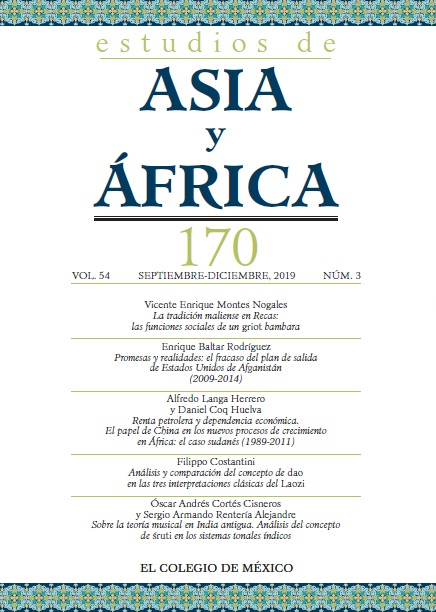Resumen
La teoría musical es un aspecto esencial en el pensamiento religioso, teológico, filosófico y literario en India, y el concepto de śruti constituye el eje de su musicología. Este artículo es un análisis introductorio en tres partes: antecedentes del śruti en el canto sāman, composición del concepto de śruti (microtono) en el sistema musical de India, y, por último, reconstrucción hipotética de las escalas primarias del sistema tonal de Bharata. La teoría musical de India muestra un proceso teórico de constantes y variables, así como de rupturas y continuidad a lo largo de su desarrollo histórico.
Referencias
Bake, A. (1979). The Music of India. En E. Wellesz (Ed.), Ancient and Oriental music (Vol. 1, pp. 195-227). Londres: Oxford University Press.
Benedetti, G. y Tonietti, T. M. (2010). Sulle antiche teorie indiane della musica. Un problema a confronto con altre culture. Rivista di Studi Sudasiatici, (4), 75-108. https://dx.doi.org/10.13128/ RISS-9118
Bharata. (1950). The Nātyaśāstra. A treatise on Hindu dramaturgy and histrionics (Vol. 1, caps. I-XXVII). (Introd. y trad. Manomohan Ghosh). Calcuta: The Royal Asiatic Society of Bengal.
Bharata. (1961). Nātyaśāstra, A treatise on Hindu dramaturgy and histrionics. (Vol. 2, caps. XXVIII-XXXVI). (Introd. y trad. Manomohan Ghosh). Calcuta: The Royal Asiatic Society of Bengal.
Clayton, M. (2000). Time in Indian music: Rhythm, metre, and form in North Indian rāg performance. Oxford: Oxford University Press. https://dx.doi.org/10.1093/acprof:oso/9780195339680.001.0001
Dāmora, C. (1952). Sangita Darpanam of Catura Damodara. (Ed. e introd. K. Vasudeva Sastri). Tanjore: S. Gopalan.
De Palma, D. (2006). Upanisads. Madrid: Siruela.
Dharma Deva, V. M. (1985). The hymns of the Samaveda Samhita. Nueva Delhi: Sarvadeshik Arya Pratinidhi Sabha.
Fox Strangways, A. H. (1914). The music of Hindostan. Oxford: The Clarendon Press.
Gautam, M. R. (1989). Evolution of rāga and tāla in Indian music. Nueva Delhi: Munshiram Manoharlal.
Gosvami, O. (1957). The story of Indian music: It’s growth and synthesis. Bombay: Asia Publishing House.
Griffith Ralph, T. H. (2004). The hymns of the Rgveda. Nueva Delhi: Motilal Banarsidass.
Jairazbhoy, N. A. (1975). An interpretation of the 22 śrutis. Asian Music, 6(1-2), 38-59. https://dx.doi.org/10.2307/833842
Jairazbhoy, N. A. (1999). Rāgs of north Indian music: Their structure and evolution. Bombay: Popular Prakashan.
Jairazbhoy, N. A. y Stone, A. W. (1963). Intonation in present day north Indian classical music, Bulletin of the School of Oriental and African Studies, 26(1), 119-132. Recuperado de http://www. jstor.org/stable/611310
Jones, W. (1799). The works of Sir William Jones. Londres: G. G. y J. Robinson.
Macdonell, A. A. (1900). A history of Sanskrit literature. Nueva York, NY: D. Appleton.
Nārada. (1964). Nāradīya Śiksa. (Ed. B. Shobhakara). Nueva Delhi: Munshiram Manoharlal.
Nijenhuis, E. te. (Introd., trad. y coment.). (1970). Dattilam: A compendium of ancient Indian music. Leiden: Brill.
Nijenhuis, E. te. (1974). Indian music: History and structure. Leiden: Brill.
Nijenhuis, E. te. (1977). Musicological literature. Wiesbaden: Otto Harrassowitz.
Olivelle, P. (Ed. y trad.). (1998). The early Upanisads: Annotated text and translation. Nueva York, NY: Oxford University Press. Recuperado de http://www.ahandfulofleaves.org/documents/the%20early%20upanisads%20annotated%20text%20and%20translation_olivelle.pdf
Pānini. (1938). Pāninīya Śiksa. (Introd., trad. y notas M. Ghosh). Calcuta: University of Calcutta.
Pānini. (2003). The Āshtādhyāyī. (Ed. y trad. Śrīśa Chandra Vasu). Delhi: Motilal Banarsidass.
Pujol, Ò. (2006). Diccionari sànscrit-català. Cataluña: Enciclopedia Catalana.
Pujol, Ò. e Ilárraz, F. G. (Eds. y trads.). (2003). La sabiduría del bosque: antología de las principales upanisads. Madrid: Trotta.
Rowell, L. (1981). Early Indian musical speculation and the theory of melody. Journal of Music Theory, 25(2), 217-244. https://dx.doi. org/10.2307/843650
Sambamoorthy, P. (1960). History of Indian music, Madras: Indian Music Pub. House.
Śārngadeva. (1978). Sangīta Ratnākara. Vol. I: Treatment of Svara. (Trad. R. K. Shringy). Delhi: Motilal Banarsidass.
Vidwans, V. (2016). The doctrine of shrutis in Indian music. Pune: Flame University. Recuperado de http://www.indian-heritage.org/music/TheDoctrineofShrutiInIndianMusic-Dr.VinodVidwans.pdf
Wade, B. C. (1994). Music in India: The classical traditions. Nueva Delhi: Manohar.
Williams, R. D. (2016). Music, lyrics, and the Bengali book: Hindustani musicology in Calcutta, 1818-1905. Music & Letters, 97(3), 465-495. https://dx.doi.org/10.1093/ml/gcw071
Esta obra está bajo una licencia internacional Creative Commons Atribución-NoComercial-SinDerivadas 4.0.
Derechos de autor 2022 Estudios de Asia y África


